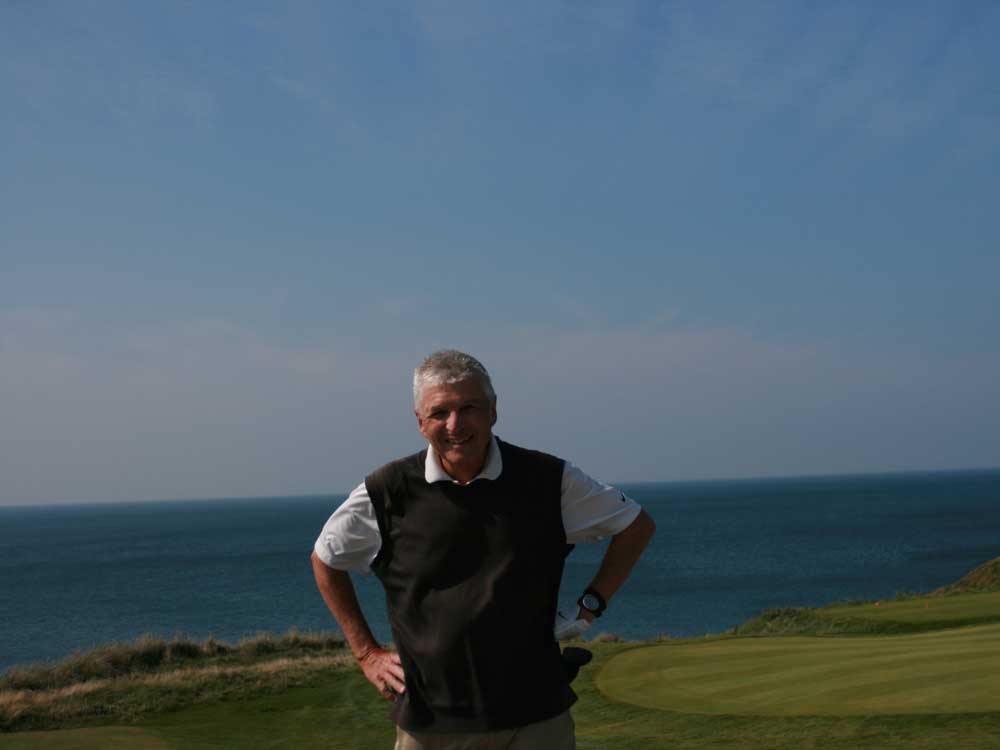Golf in Wales: Not your Central Oregon courses
Published 12:00 am Monday, October 5, 2015

- Blaine Newnham / Submitted photoRon Bellamy poses in the fairway with the Irish Sea behind him on the links at Nefyn & District Golf Club in Wales.
LLANDUDNO, Wales — Living in Central Oregon, you don’t have to go far to find a destination golf course, designed by some of the biggest names in golf.
They’re all around you.
Trending
There’s Pronghorn, with courses by Jack Nicklaus and Tom Fazio. Tetherow, designed by David McLay Kidd. Brasada Ranch, designed by native Oregonian Peter Jacobsen, with Jim Hardy.
They are high desert courses, the oldest of which is the Nicklaus course at Pronghorn, which opened in 2004.
In that vein, there couldn’t be a more different destination to consider than North Wales, where true links courses, on the coast of the Irish Sea, date their beginnings to the 1890s and early 1900s, and were designed by legends such as James Braid and Harry Colt.
Play Wales, and you’re walking through the divots of history.
A few weeks ago, I played six courses in North and Mid Wales at the invitation of Visit Wales, the tourism and marketing division of the Welsh government, which has a one-stop website for anyone planning an excursion to Wales: www.visitwales.com/golf.
Joining me were Blaine Newnham, the former sports editor and columnist of The Register-Guard in Eugene and the retired longtime columnist for the Seattle Times; Tom Cade, senior director of communications for the Pacific Northwest Golf Association and editor of Pacific Northwest Golfer magazine, and Rob Perry, of Bellevue, Washington, a professional golf photographer.
Trending
After flying in to Manchester, England, we drove to Llandudno, a Victorian-era resort town on the northern coast of Wales, where the writer known as Lewis Carroll saw the inspiration for “Alice in Wonderland,” and where there are shops, hotels and restaurants. In six days, we played North Wales Golf Club in Llandudno and nearby Conwy Golf Club, drove 90 minutes south to play Nefyn & District Golf Club, with its spectacular views of the sea, and nearby Porthmadog Golf Club, then drove into the top of Mid Wales to play venerable Royal St. David’s, in the shadow of Harlech Castle, and Aberdovey.
“There are great golf courses, but they are not as well-known outside Europe,” said David Williams, the captain at Conwy Golf Club and a golf architect with 30 courses to his credit. “I would say there are some great courses that if they were in other areas they would be better known.”
Certainly, once you get there, the courses are affordable, especially in comparison with places such as Pronghorn, where green fees can surpass $200, or Bandon Dunes on the Oregon Coast, or the trophy courses in Ireland. And lodging options range from historic hotels to affordable bed-and-breakfasts.
Weekday rates at the courses we played ranged from roughly $53 (converting from British pounds) at North Wales and $57 at Porthmadog (pronounced Port-Mad-Oc) to $70 at Conwy and Nefyn, and $100 at Royal St. David’s and Aberdovey.
“The value for the money in North Wales is great,” said Richard Bradbury, head professional at North Wales Golf Club, where he has worked for 30 years. “Golf here is very undervalued.”
Wales itself is an area about the size of Massachusetts, jutting out into the Irish Sea, surrounded by water on three sides. The scenery is superb — the mountains of Snowdonia National Park, castles dating from the 1200s, countryside with stone cottages, and steep hillsides where sheep graze and where stone walls seem to stretch to the sky.
Some brief glimpses: North Wales Golf Club, founded in 1894, is wedged between railroad tracks and Llandudno Bay, and the clubhouse is an unpretentious neighborhood storefront. The fairways are undulating, there are some blind shots (and a couple of observation towers, from which to watch your partner’s tee shot) and some rough edges, and some holes straight along the bay and into the dunes. Conwy hosted a qualifying tournament for the British Open — the Open Championship, as it’s known in the United Kingdom — in 2006, and has hosted three European Seniors Tour Events, and is a tough links course with a strong reputation; Nefyn & District has the most spectacular views, with eight holes on a peninsula, including the iconic par-4 13th hole, where you can hook the ball into the Irish Sea, or slice it into a bay.
Porthmadog is a tale of two nines, the front nine sedate and parklike, with trees and a pond, like a course you might find in the Portland area, the back nine rugged links in the dunes; Royal St. David’s, overlooked by Harlech Castle, is a great course, separated from the sea by a wide swath of dunes, a course that would host the Walker Cup if only there were enough hotel rooms in Harlech; and Aberdovey is a classic links course, dating to 1892 and also separated from the waves by the dunes and memorialized in the writings of the pioneering golf journalist, Bernard Darwin.
If you ever make the trip, remember to take plenty of golf balls — they’re more expensive in Wales than in the United States, and while the courses look open, the thick rough can truly gobble up golf balls, and the gorse is impenetrable. (I lost 18 balls over the course of the six rounds.) And remember that wind is a constant on the seaside courses, and rain is not infrequent — though we lucked out in that department — so every day the courses present a different challenge.
“We’re very lucky,” Bradbury said. “Every day the scenery is different.”
Which is part of the magic of true links golf.
— Ron Bellamy is a former sports editor and columnist for The (Eugene) Register-Guard. For more information on the courses he played, visit ronbwriter.com. He can be reached at ronbwriter@aol.com.








